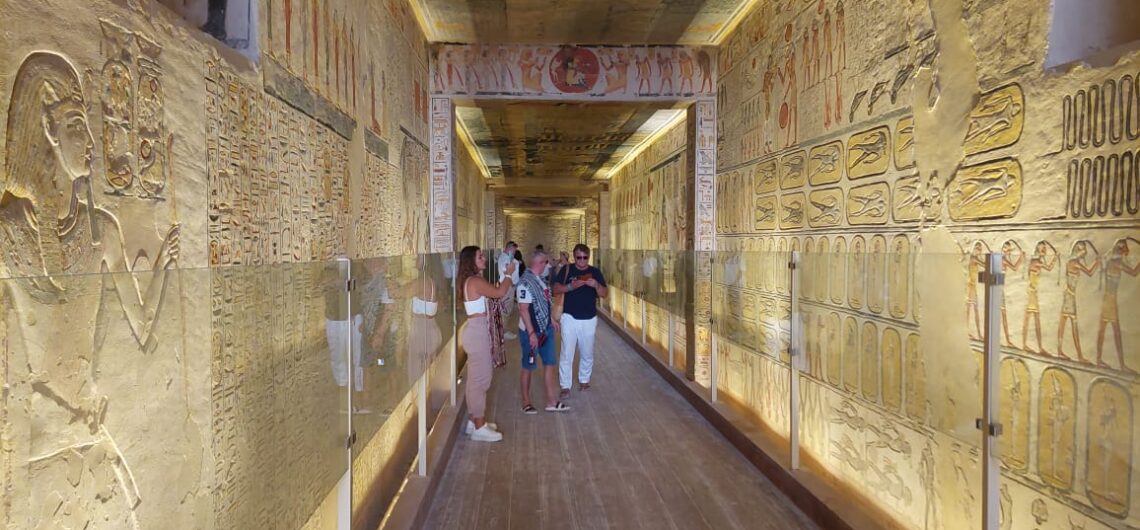Valley of the Kings in Luxor, Egypt | Ancient Egyptian Tombs Facts in Ancient Egypt.
Discover new secrets about the civilization of ancient Egypt and the Ancient Egypt History that you did not know before about the royal Egyptian tombs of the Egyptian Pharaohs kings, from the rulers of the Pharaonic queens of Egypt “Female Pharaohs” and the kings of the Pharaohs, the Eighteenth Dynasty of Egypt, the Nineteenth Dynasty of Egypt, and the Twentieth Egyptian Dynasty of the era of The New Kingdom of Egypt.
what are the stages of discovering the valley, the discoverers, and what It is the architectural design of the cemetery, a complete list of all the tombs within the valley, and more about the most important and famous Egypt Archaeological Sites.
Valley of the Kings Secrets Serious:
- There is a basement of 100 meters in length Tomb of King Seti I ends with the secret burial chamber of the Pharaonic king and is believed to contain treasures and secrets hidden until now.
- Owns individuals Abdel Rasool Family to hidden secrets that no one knows Egyptology around the world so far, there are treasure places and royal tombs in the region Luxor “Thebes” Especially Mount Qurna.
- Many researchers and Egyptology believe that there are still royal and non-royal tombs that have not been discovered in the Qurna region and the Valley of the Kings.
- It is believed to be the tomb of King Ramses VIII, king Amenhotep I and King king Smenkhkare and a cemetery Queen Nefertiti, It is located in the Valley of the Kings and is being searched for in the northern and southern regions by Egyptian and foreign missions.
- It is believed that there are Royal Tombs hidden behind the rocks of the Mortuary Temple of Hatshepsut in Deir El Bahari. It was built under the supervision of the engineer and minister Senenmut, and he had a love story with Queen Hatshepsut.

Valley of the Kings Tombs Facts:
- The Valley of the Kings contains 65 Pharaonic tombs, including 26 royal tombs of Egyptian Pharaohs kings, The rest are non-royal tombs for nobles and High Priest of Amun and Queens of Egypt and princesses and princes, children of kings and senior officials in the state, including the leader army “Military of ancient Egypt” and the grain storekeeper and others in Ancient Egyptian Government.
- “A detail of the king’s journey to the other world was filmed as in Ancient Egyptian religion.” Aaru on the walls of tombs by artists, sculptors and workers The New Kingdom in ancient Egypt to Discover the extent of the development of the art of Sculpture in Ancient Egypt and Architecture in ancient Egypt, Which is considered the Pharaonic Golden Age, especially the era Eighteenth Dynasty of Egypt with high precision, which maintains its quality and colors until now.
- He was keeping with Mummy King Funerary Equipment and food, fruits, and drinks such as wine “Food in ancient Egypt” and Pharaonic beer, so that he could use them after that on his journey with the disk of the sun every day.
- It was kept inside the Royal Ancient Egyptian Coffins small Ushabti Statue and Pharaonic Scarab of workers and servants to serve the king in the afterlife.
- Since 1973 AD, only foreign missions have had the right to excavate, dig, and search for graves Pharaohs and treasures Egyptian Antiquities.
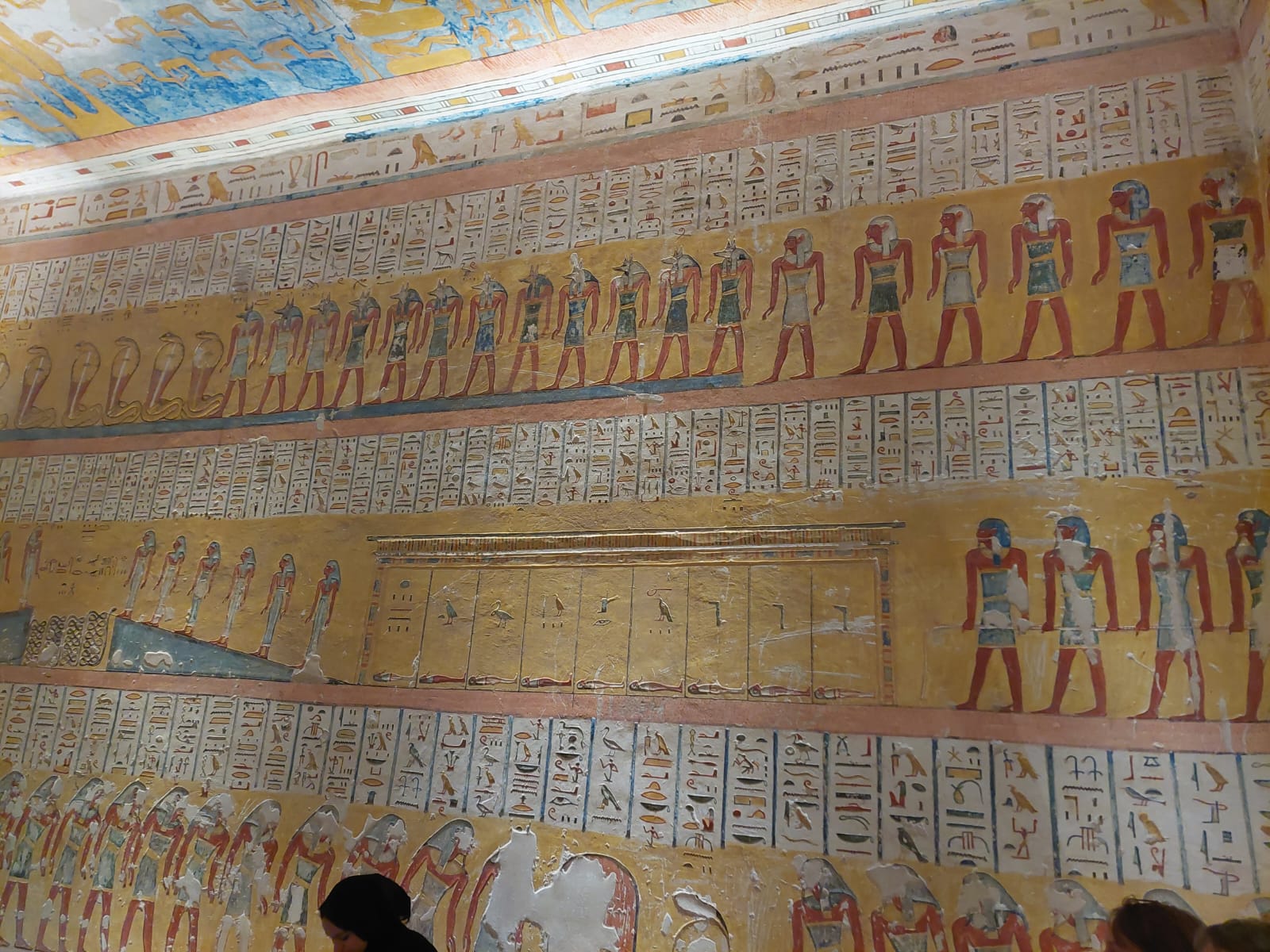
- The Abdel Rasoul family is considered one of the most famous families that hosted foreign and Egyptian delegations at the Al-Marsam Hotel on the Western Bank and helped them discover the tombs and Pharaonic crypts and The Royal Cache of Deir el-Bahri, She still has secrets that no one knows except them.
- considered as Tomb of King Ramses III | KV11 was originally intended for the burial of a mummy King Setnakhte father King Ramses III however “The Ramesside Period“, the younger king buried his father in Cemetery No. KV14 and then developed his father’s cemetery until he was buried there after his death.
- Most of the royal tombs were built in the eastern direction of the Valley of the Kings, and then there are 4 tombs in the western direction, To indicate the development of Ancient Egyptian science.
- The treasures of all the royal tombs in the valley were Ancient Egyptian Grave Robbers from residents Thebes Western and the explorers and those searching for Pharaonic treasures.
- All tombs contain Pharaonic drawings and engravings for use in the second life after death Where scenes of the king were painted with Egyptian deities as stated in the texts Book of Gates, Book of Caverns, Book of Amduat, The Book of the Heavenly Cow, The Book of the Dead.
- It is considered the Valley of the Kings in the short est with in World Heritage Sites in Egypt Continue to organized UNESCO for researchers and studies in science Egyptology and science History Of Egyptian Civilization and Monuments around the world.
- King Setnakht captured Tomb of Queen Twosret KV14 “wife of King Seti II“, after he faced the problem of cracks occurring between the rock layers and entering the Tomb of King Amenmesse KV10, It was discovered by Egyptologists.
- King Ramesses III restored Tomb No. KV11 of his father, King Setnakht.
- The Tomb of King Ramses II was built No. KV7 on Architectural Design Pharaonic, The arch is the result of the tomb being dug in sedimentary rocks resulting from a rock collapse in the Valley of the Kings after the Nile River floods every year.
- The Valley of the Kings was exposed to a series of heavy floods at the end of the 18th Dynasty, as all the tombs of the royal families disappeared under sediments of water Nile River After the flood.
- The hills in the Valley of the Kings area are exposed to 7 paths of flood water that flow into the heart of the valley, in addition to being exposed to thunderstorms.
- All of the royal tombs in the Valley of the Kings in Luxor are 100% carved from rock.
- The royal tombs contain more than 2,100 Pharaonic inscriptions on the walls, demonstrating its splendor Sculpture and The Art of Painting in Ancient Egypt, To tell us what Social Structure in Ancient Egypt Pharaohs..
- The tomb of King Ramses V No. 9, which belongs to King Ramses V and King Ramses VI, contains 100 Pharaonic inscriptions and was built in 278 BC.
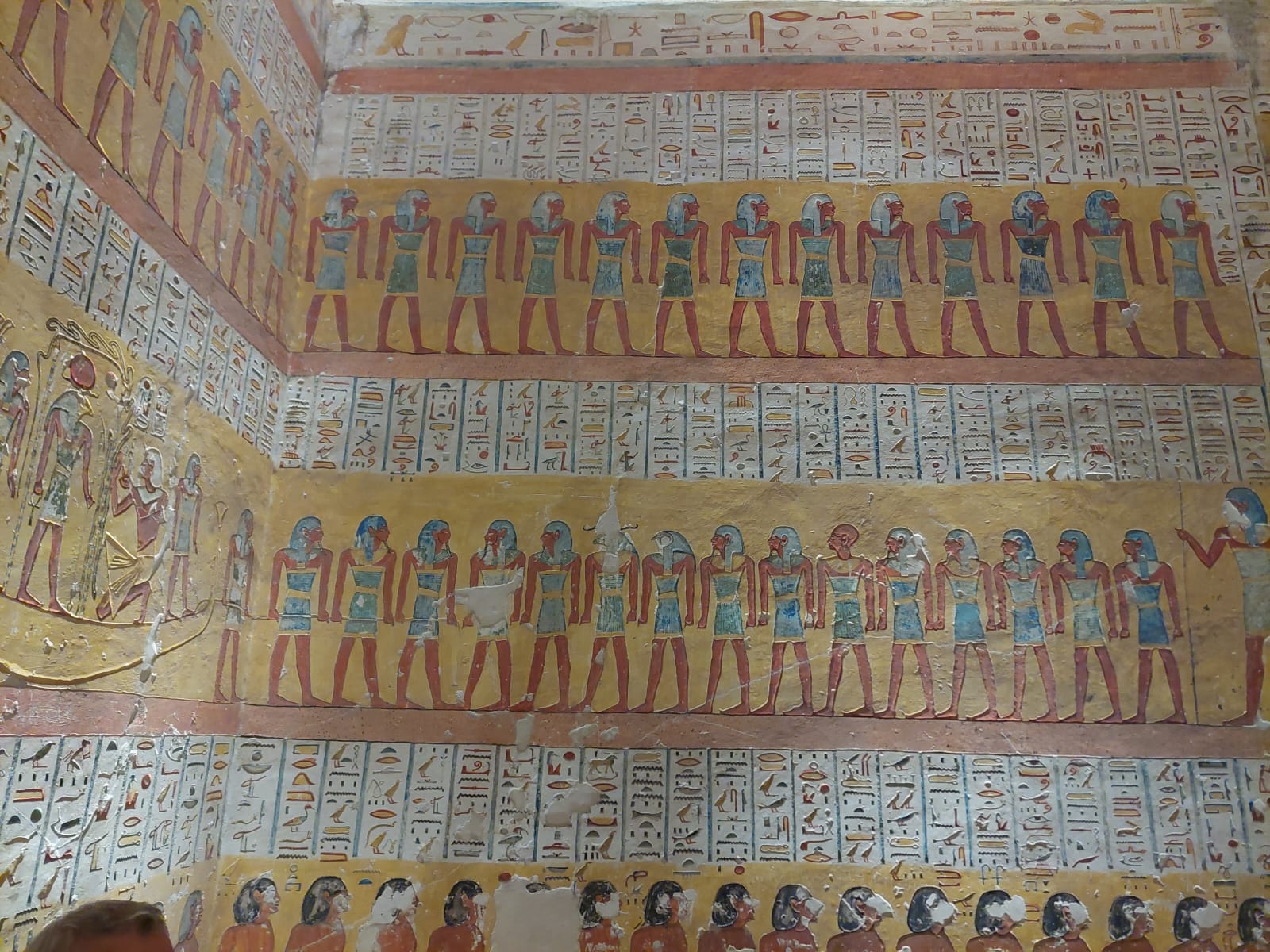
- The first drawing was done Map of Egyptian Monuments Certified for the Valley of the Kings in 1799 AD, by the French archaeologist Dominique Vivant “Baron Denon” You One of the scholars and experts of Egyptology and the expedition accompanying him from France in cooperation with Egyptian Ministry of Tourism and Antiquities.
- Several documentaries have been produced by all directors around the world, especially films about Tomb of Tutankhamun KV62, In addition to the films being produced so far in Hollywood, New York.
- Most of the royal tombs are small in size, consisting of a single room for burial through a stairway leading to a passage downwards, or a path to a well dug down underground, or a group of complex passages to reach the end of the burial chamber of the king’s coffin and discover the extent of the development of Mummification in ancient Egypt.
- The remains of animals were found buried in one of the graves, while a group of graves was not used or anyone was buried in them..
- considered as Tomb of King Ramses VII KV1 for King Ramesses VII, The first tomb discovered until Tomb No. KV63 in 2005.

Why did they choose the Valley of the Kings?
- The valley is located on the western bank of the Nile River in an area completely deserted of population and life during the Pharaonic New Kingdom era from the period 1550 to 1080 BC as in Geography of ancient Egypt.
- Preserving the king’s mummy from being stolen and plundered by tomb thieves until he is resurrected in the other world after death, which was widespread in that period, but the matter was not a secret for a long time, as tomb thieves would steal gold “Ancient Egyptian Metallurgy” and the king’s belongings and break the royal Pharaonic coffins and the mummy to obtain on treasures, jewels and everything valuable buried with the king as in Clothing in ancient Egypt.
- It was the idea of the ancient Egyptian engineer to build a fortified tomb dug into caves in the mountain rocks of Mount Qurna.
- The valley’s soil is characterized by being composed of several layers of limestone, sedimentary rocks, and layers of marl clay.
- The valley’s hills are characterized by the pyramidal shape of the summit, and it was also used in construction and as one of the secrets of building The Pyramids of Giza in Cairo as royal tombs in the era of the Old Kingdom of Egypt, beginning with the rule of King Djoser of the Third Dynasty of Egypt and the rule of King Sneferu in rule in Fourth Dynasty of Egypt.
- The Valley of the Kings is considered an isolated area from the residential community. Therefore, the main goal was to protect the royal tombs from tomb thieves, especially the thieves of the western Thebes region, after the spread of famine and Revolutions in Ancient Egypt and chaos among the regions of southern Egypt. Industry in ancient Egypt deteriorated, and there were no strong kings and rulers to enforce the Law in Ancient Egypt “Maat“.
- The valley is not exposed to much rain throughout the year. When floods occur, it follows its own path and leaves sediments only at the entrances to the tombs, as happened in the tomb of King Tutankhamun, known as the Little King..
- There is a large geological difference between rock layers, between fine, smooth layers, large rock layers, and layers of superficial shale..
The ancient Egyptians had a strong belief in the doctrine of reckoning and resurrection after death.”Religious life in ancient Egypt”, as a result of observing the sunrise in the east and sunset in the west daily and repeating it every day without interruption or stopping.
In addition, the Nile River floods every year, then recedes, then returns with silt and good things as in Agriculture in Ancient Egypt. Here, the ancient Egyptian Pharaohs realized the doctrine of awakening after death and resurrection for reckoning, and the manifestations were drawn Funerary Religious beliefs in the civilization of ancient Egypt on the walls of tombs.
List of Pharaonic tombs in the Valley of the Kings of Luxor:
Most of the royal tombs were built in the eastern direction of the Valley of the Kings, then there are 4 tombs in the area of the west direction.
| NO. | Name of the king. | Dynasty |
| KV 1 | Tomb of King Ramses VII | KV1 | 20 |
| KV2 | Tomb of King Ramesses IV | KV2 | 20 |
| KV3 | Tomb of the sons of King Ramses III | 20 |
| KV4 | Tomb of King Ramesses XI | KV4 | 20 |
| KV5 | Tomb of the Sons of King Ramses II | 19 |
| KV6 | Tomb of King Ramesses IX | KV6 | 20 |
| KV7 | Tomb of King Ramesses II | KV7 | 19 |
| KV8 | The Tomb of Merenptah | KV8 | 19 |
| KV9 | Tomb of King Ramses V + King Ramesses VI | KV9 | 20 |
| KV10 | Tomb of King Amenmesse | KV10 | 20 |
| KV11 | Tomb of King Ramesses III | KV11 | 20 |
| KV12 | Tomb of the Royal Family | 18-19 |
| KV13 | Tomb of Bay | KV13 “Tomb of Amenherkhepshef, son of Ramesses IX, an, son of Ramesses VI”. | 29 |
| KV14 | Tomb of Tausert + King Setnakhte | KV14 | 29 |
| KV15 | Tomb of King Seti II | KV15 | 19 |
| KV16 | Tomb of King Ramesses I | KV16 | 19 |
| KV17 | Tomb of King Sethi I | KV17 | 19 |
| KV18 | Tomb of King Ramesses X | KV18 | 20 |
| KV19 | Tomb of Prince Mentuharepshef and King Ramesses VIII | KV19 | 20 |
| KV20 | Tomb of King Thutmose I + Queen Hatshepsut | KV20 | 18 |
| KV21 | Unknown. | New Kingdom |
| KV22 | The Tomb of Amenhotep III | KV22 / WV22 | 18 |
| KV23 | The Tomb of King Ayi | KV23 / WV23 | 18 |
| KV24 | Unknown | 18 |
| KV25 | Unknown | 18 |
| KV26 | Unknown | New Kingdom |
| KV27 | Unknown | New Kingdom |
| KV28 | Unknown | New Kingdom |
| KV29 | Unknown | New Kingdom |
| KV30 | Unknown | 20 |
| KV31 | Tomb of the family of King Tuthmosis III | KV31 | New Kingdom |
| KV32 | Queen Tia’a tomb | KV32 | 18 |
| KV33 | Unknown | New Kingdom |
| KV34 | Tomb of King Thutmose III | KV34 | 18 |
| KV35 | Tomb of King Amenhotep II | KV35 | 18 |
| KV36 | Tomb of Maiherpri | KV36 | 18 |
| KV37 | Unknown | New Kingdom |
| KV38 | Tomb of King Thutmose I | 18 |
| KV39 | Tomb of Amenhotep I | KV39 | 18 |
| KV40 | Unknown | New Kingdom |
| KV41 | Unknown | 18 |
| KV42 | Tomb of Queen Merytre-Hatshepsut Ra | KV42 | 18 |
| KV43 | Tomb of Thutmose IV + Prince Amenemhat son of Thutmose III, and Princess Tentamun | KV43 | 18 |
| KV44 | Unknown | New Kingdom |
| KV45 | Tomb of Userhet | KV45 | 18 |
| KV46 | Tomb of Yuya and Thuya | KV46 | 18 |
| KV47 | Tomb of Siptah | KV47 | 18 |
| KV48 | Tomb of Amenemipet “Pairy” | KV48 | 18 |
| KV49 | Unknown | 18 |
| KV50 | Unknown | 18 |
| KV51 | Unknown | 18 |
| KV52 | Unknown | 18 |
| KV53 | Unknown | New Kingdom |
| KV54 | Unknown | 18 |
| KV55 | Tomb KV55 | 18 |
| KV56 | Unknown | 19 |
| KV57 | Tomb of Horemheb | KV57 | 18 |
| KV58 | Unknown | 18 |
| KV59 | Unknown | New Kingdom |
| KV60 | Tomb of Queen Hatshepsut | KV60 | 18 |
| KV61 | Unknown | New Kingdom |
| KV62 | Tomb of Tutankhamun | KV62 | 18 |
| KV63 | Unknown | 18 |
| KV64 | Unknown | New Kingdom |
| KV65 | Unknown | New Kingdom |
Valley of the Kings Tombs Architect:
It was completed The tomb was designed to serve the Pharaonic king on his journey in his second life towards the underworld and It expresses architecture and the development of Astronomy in ancient Egypt, It begins with a long corridor that descends downward in a 90-degree turn until the burial chamber.
He was The burial chamber was initially designed according to the figure Pharaonic Egyptian Cartouche or what the Pharaohs called the sacred axis. The door of the room was hidden with sand after the king’s mummy was buried in the coffin, and then the upper passage was filled with stones..
with The beginning of an era King Tutankhamun Gradually, the design of the tomb began in a straight shape, shown with the jogging axis, then relying on the design of the straight axis, especially the tombs Nineteenth Dynasty of Egypt and Twentieth Egyptian Dynasty.
It was completed Digging and building a group of wells to draw rainwater and floods that reach the cemetery, which is not found in a group of royal tombs of the 20th Dynasty. The ancient Egyptians believed that dug wells swallow evil spirits and thieves who steal the cemetery’s treasures..
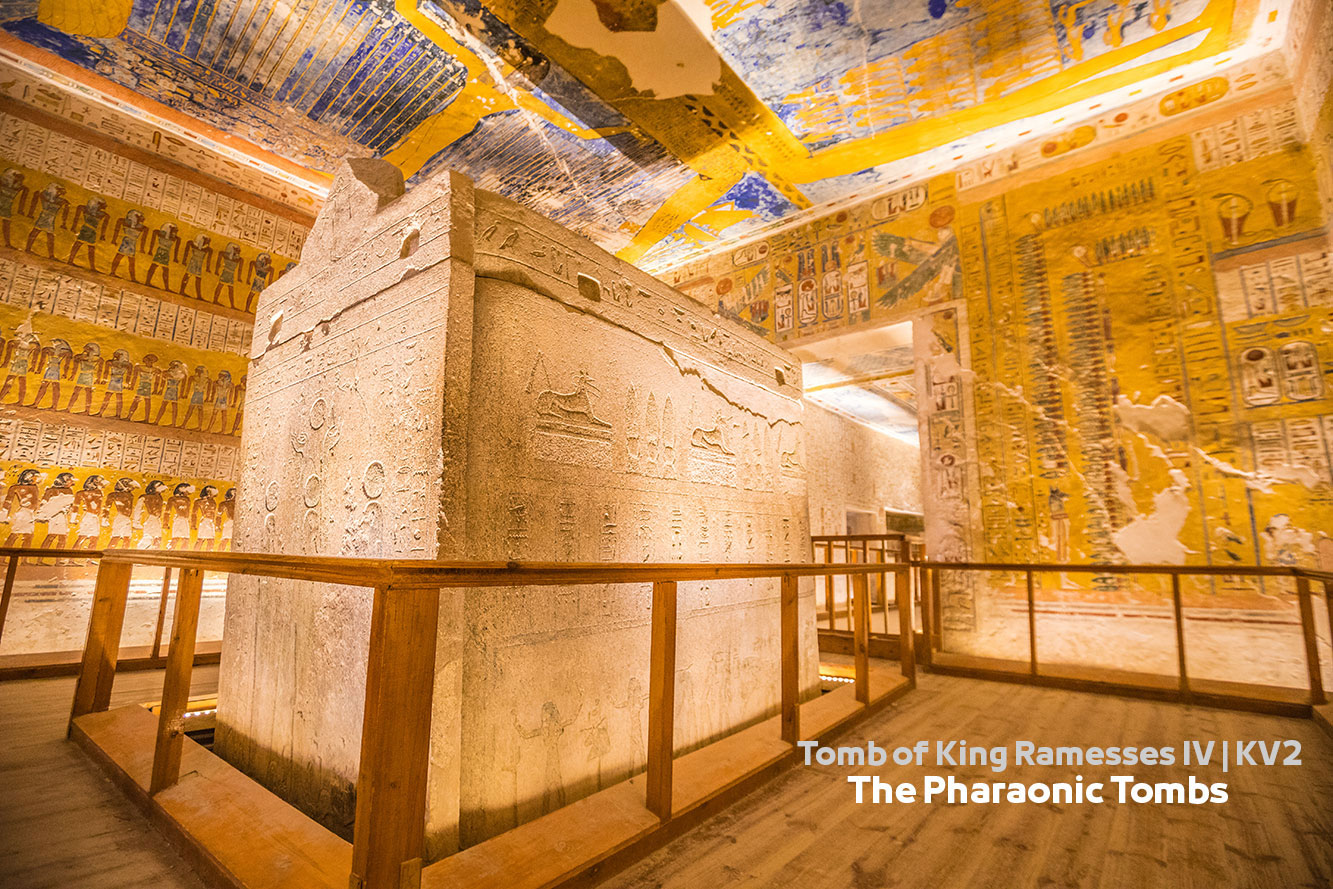
Valley of the Kings Artifacts:
It was completed Most of the royal tombs in the Valley of the Kings are decorated with sacred carvings depicting the journey of Aru and the sun god from darkness for 12 hours until the first dawn..
Developments Ancient Egyptian decoration on the walls since ancient times King Horemheb “He has Tomb of Horemheb in Saqqara and The Speos Of Horemheb in Aswan.”, Where engravings were drawn of the sun god of the Pharaohs and his journey through 12 gates of darkness until his ascension to heaven the next day, one of the discoveries of religious life in ancient Egypt.
No The tombs of kings in the early eras contain many decorations, while the tombs of nobles do not contain any decorations as in Tombs of The Nobles in Luxor, The Pharaonic Tombs from Thebes.
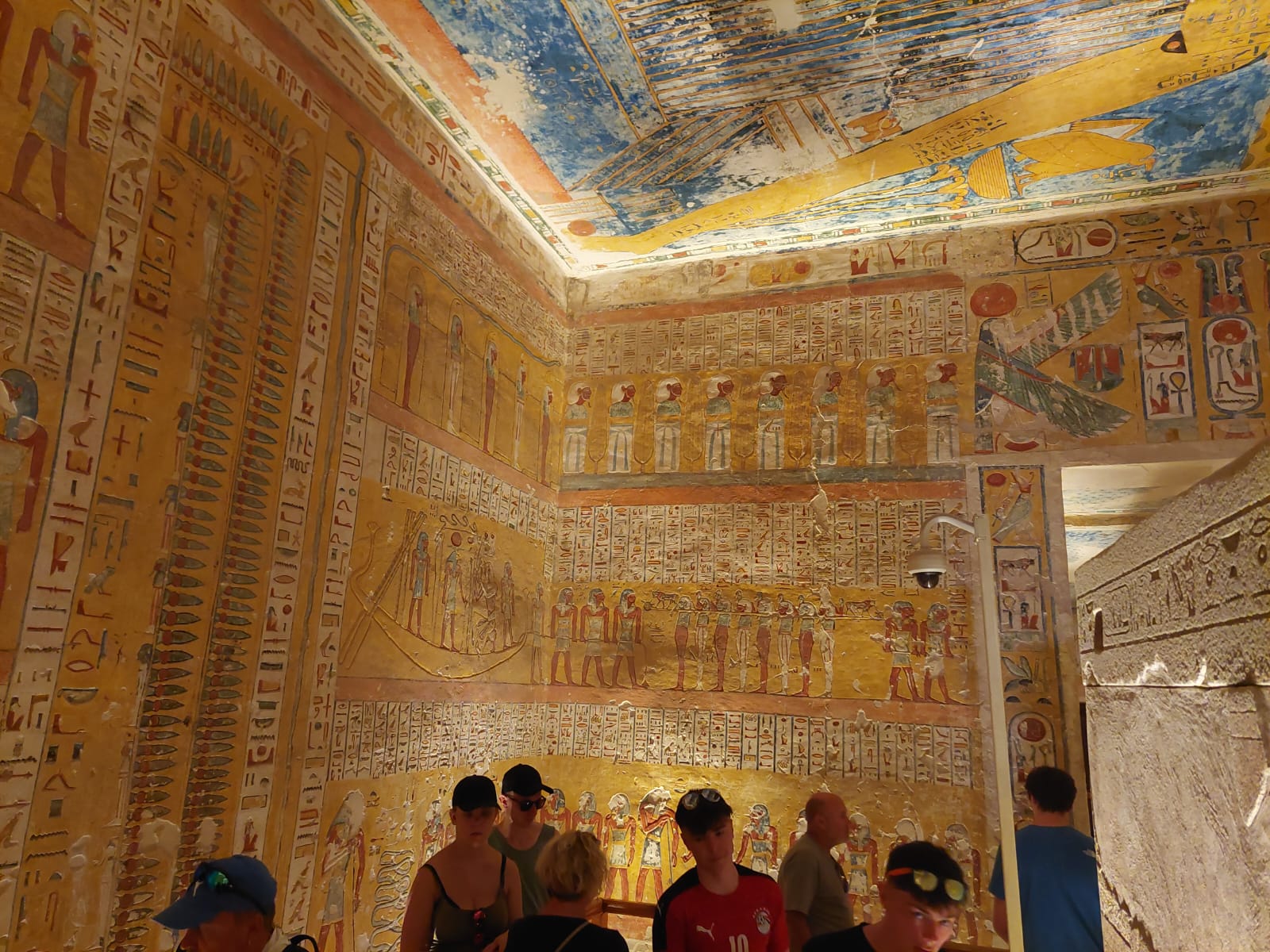
Take care The kings of the 19th Dynasty added inscriptions and inscriptions to the walls in the upper parts of the tomb. These texts were considered sacred by the Pharaohs for the second life, one of the most important Religious rituals in Pharaonic civilization.
where The ancient Egyptian gods, kings, and all the servants and slaves gather, waiting for the sun god to ascend to the sky to bring everyone back to life, as was believed in ancient Egyptian religious beliefs..
King Seti I added decorations in Cemetery No. KV17 and religious texts from the book of the dead, The Book of the Cow heavenly, book caves, The Book of Gates with inscriptions of the deceased praying to the sun god to resurrect him for a new life.
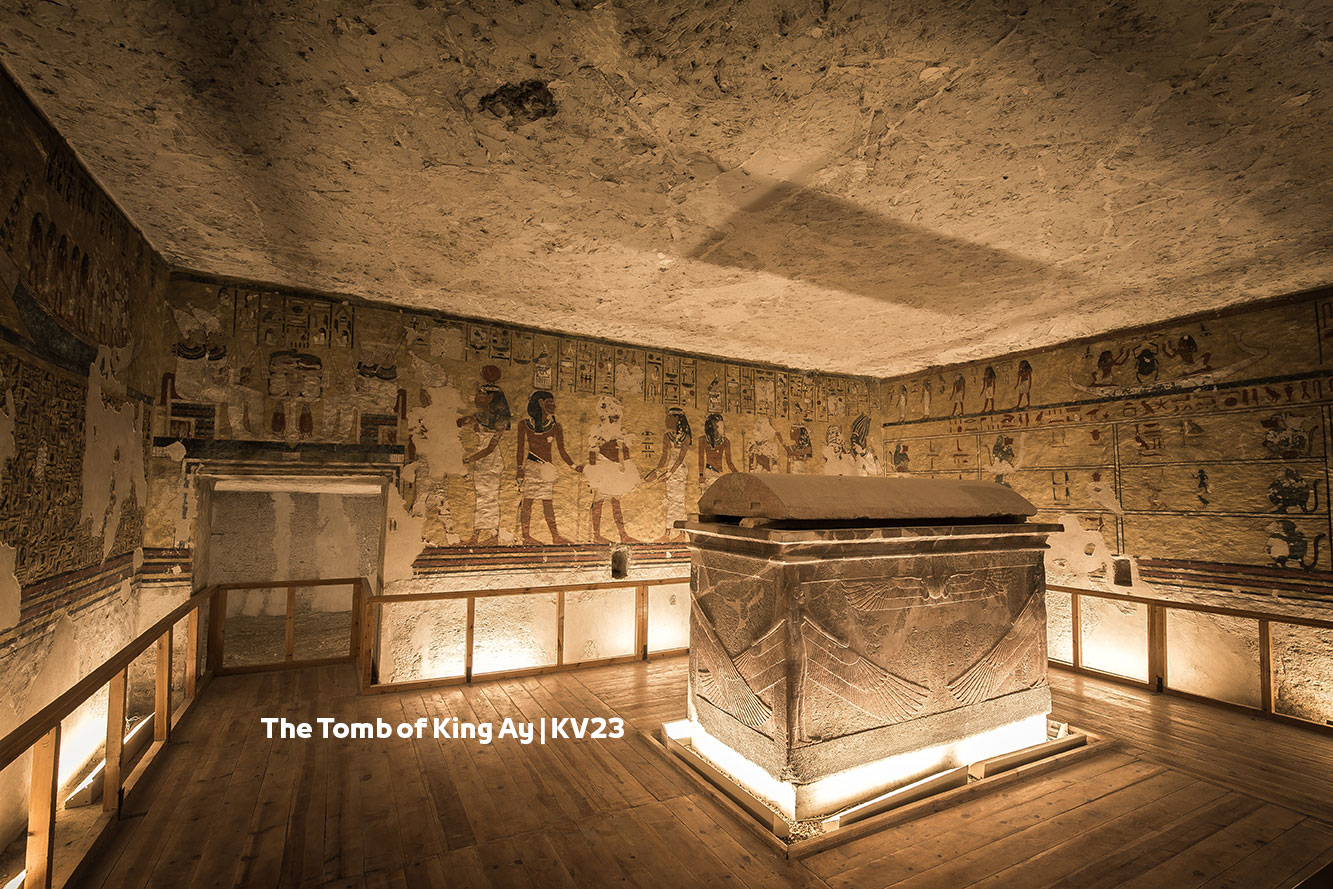
Valley of the Kings Discoveries:
- Starting in 1750 AD, all exploratory trips to search for tombs and treasures in the Valley of the Kings stopped for 50 years due to wars, until the French expedition came to Egypt led by the commander Napoleon Bonaparte.
- Cause Giovanni Battista Belzoni destroyed many Pharaonic antiquities as a result of his incorrect and unscientific method of excavating antiquities, as his primary goal was to uncover treasures and then resell them to people around the world without caring about preserving the cemetery or the archaeological treasures.
- Discovered The Tomb of King Ayi ““He became the Pharaoh of Egypt after the death of King Tutankhamun, married his wife, Queen Ankhesenamun, and received the Coronation of the Pharaohs.”” for king Ay “Kheper Khabru Ra Ay” No. KV23, 1816 AD “He has Tomb of Ay – Ta 25, that is, among the Tombs of the Nobles Amarna in Minya during the reign of King Akhenaton and his wife, Queen Nefertiti, in Tell el-Amarna“, and Tomb of king Seti I No. KV17 in 1817 AD by the Giovanni Belzoni.
- Tomb of Queen Merytre-Hatshepsut Ra | KV42, belonging to the Pharaonic Queen Merytre-Hatshepsut, wife of King Thutmose III, and the tomb of King Thutmose I and Queen Hatshepsut, belonging to King Thutmose I No. 20, were discovered in 1908 AD by the English archaeologist Howard Carter.
- Discovered Tomb of Thutmose IV + Prince Amenemhat and Princess Tentamun | KV43 for King Thutmose IV, Tomb of Yuya and Thuya | KV46, Tomb of Horemheb | KV57 by the American lawyer Theodore M. Davis and the expedition of the English archaeologist Edward Russell Ayrton.
- King Tutankhamun’s tomb No. KV62 was discovered in 1922 AD by an archaeologist Howard Carter “have Howard Carter House in Luxor” and a group of Egyptology researchers.
What Egyptian tombs are still undiscovered? Royal tombs not yet discovered:
- Tomb of Queen Set Kamos, wife of King Amenhotep I.
- graveyard Queen Ahmose first wife King Tuthmosis I.
- The tomb of Queen Mut-Neferet, the second wife of King Tuthmosis I.
- Wives’ graves King Thutmose III.
- Tomb of King Ramesses VIII.
- Tomb of King Amenhotep I.
- Tomb of King king Smenkhkare.
- Tomb of Queen Nefertiti.
- graveyard Queen Tiye wife King Amenhotep III.
- Tombs of King Akhenaten’s wives.
- Wife’s grave King Siptah.
- Tomb of King Setnakht’s wife.
- Tomb of King Ramesses III’s wife.
- Wife’s grave King Ramesses IV.
- Tombs of King Ramses V’s wives.
- Tomb of King Ramesses VI’s wife.
- Wife’s grave King Ramesses IX.
- Wife’s grave King Ramesses X
- Tombs of King Amunmes’ wives.

Discovery of the Valley of the Kings:
- The first person to discover the tombs of the Valley of the Kings was the Egyptian engineer Anini. A text written on a plaque was discovered in the tomb of King Tuthmosis I indicating that he dug the tomb alone without anyone’s help.
- The explorer Sikar is considered the first to write about the Pharaonic antiquities in the city of Thebes and the tombs of the Valley of the Kings.
- The Roman explorer Diodorus Sicily wrote in his historical books that the Valley of the Kings contains 17 tombs.
- The English explorer Richard Pocock visited Egypt in 1737 AD and wrote in his historical books that the Valley of the Kings contains 14 royal tombs.
- The English Consul, James Bruce, in Algeria, embarked on a tour and trip to uncover the secrets of the sources of the Nile River. He visited the city of Luxor and the tombs of the Valley of the Kings. He cleaned the tomb of King Ramses III and wrote a description of it in his memoirs.
- An Italian circus performer Giovanni Battista Belzoni visited Egypt in 1815 AD and began searching and excavating antiquities and treasures in the western region of the Valley of the Kings.
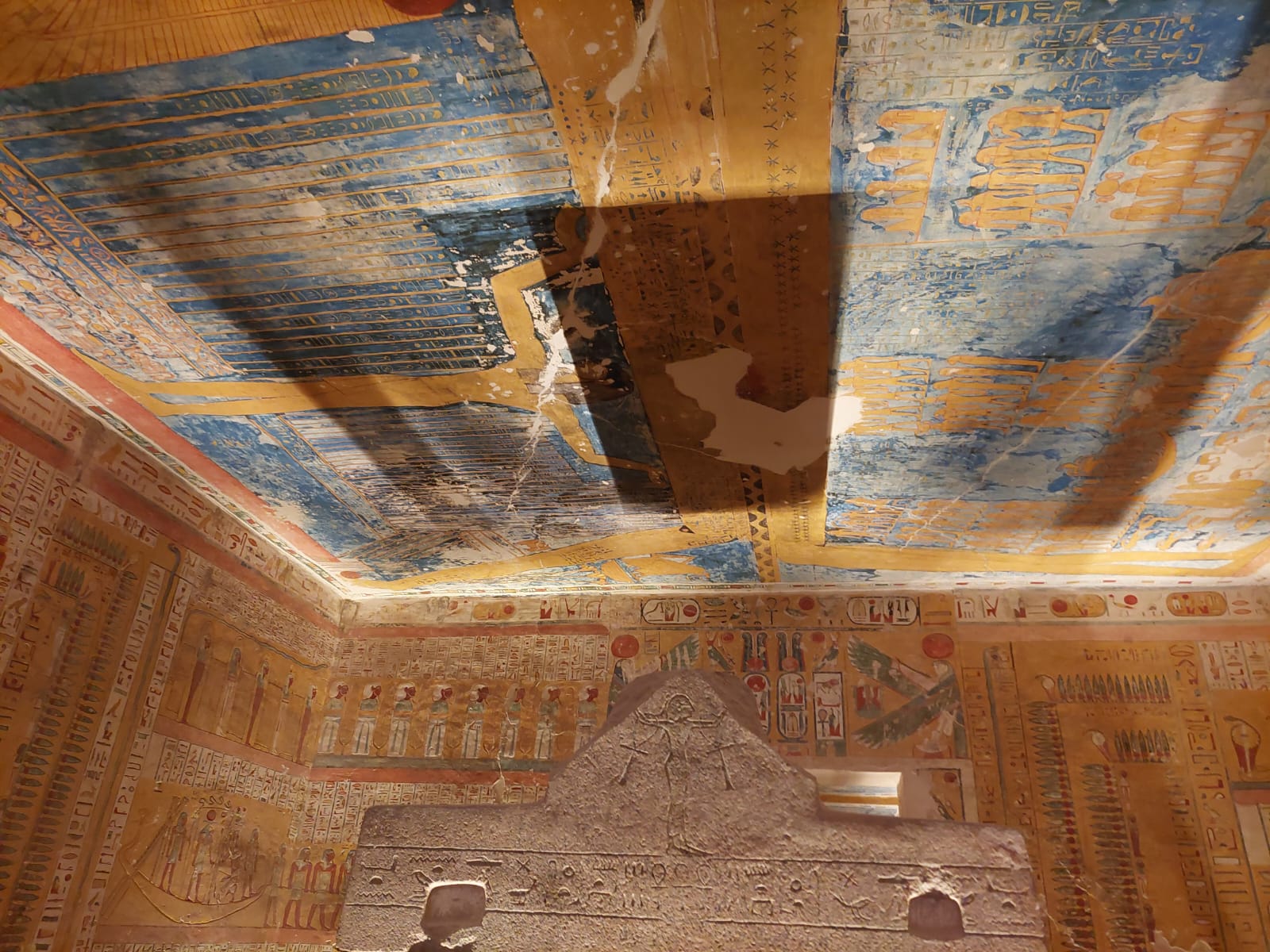
- Archaeologist John Gardner Wilkinson established the science of Pharaonic archeology in 1824 AD. He was one of the first to number and give tomb numbers in red ink at the entrances to the cemetery, and he still does.TUsed so far.
- Visit the archaeologist Jean-François Champollion “Discoverer of the translation of the Rosetta Stone and the Ancient Egyptian Language“, He traveled to Egypt in 1829 AD with a French-Italian mission. He was interested in re-entering 16 royal tombs and re-describing them. At that time, he said:Champollion“The Valley of the Kings has no other tombs that can be discovered anymore.”
- There was an effort to discover new tombs in the valley from Burton Rosolini and Rolinso Lipsius, but unfortunately a report was presented that the valley was devoid of new royal tombs.
- Discovered Tomb of King Amenhotep II KV35 via the researcher Victor Loret in 1898 AD, 9 mummies were discovered inside the burial chamber and 4 other non-royal mummies.
- The American Theodore Davis made many attempts to excavate Pharaonic treasures in 1902 AD.
- The tomb of King Tuthmosis IV was discovered by English archaeologist Howard Carter.
- Many non-royal tombs have been discovered by researchers Ayrton and Wigal Davies.
- Archaeologist James Burton made many discoveries inside the valley.
- Auguste Maret, Director of the Department of Antiquities and Founder The Egyptian Museum “Museums in Cairo” in Tahrir Square, He made many discoveries until he reached the point that the valley contains 25 tombs, and he restored, painted and planned the royal tombs.
- Archaeologist Victor Loret added 16 tombs to the map of royal and non-royal tombs in the valley.
Giovanni Battista Belzoni and his discoveries in Valley of the Kings:
He worked in the heroic circus, lifting weights and lifting a pyramid for a group of people. He was called Hercules of the Pentagon. He arrived in Egypt in 1815 AD to search and excavate the Pharaonic golden treasures in Luxor and archaeological sites.
Giovanni Battista Belzoni was assisted by the British Consul Henry Salt, who was secretly working in the trade in Pharaonic antiquities.
- Giovanni Battista Belzoni discovered many huge pharaonic statues in the Valley of the Kings and delivered them to Henry Salt and sold them to people around the world.
- Giovanni Battista Belzoni stole the coffin of King Ramses III and sold it to one of the kings of France with the help of the British consul after transporting it via huge boats on the Nile River and then to giant ships. In Alexandria Then to France, it was preserved and is now displayed in the Louvre Museum in Paris, France.
- He discovered 9 tombs, including 4 royal tombs, which is the King’s Tomb, No. KV23 and Tomb of King Ramesses I KV16, the tomb of King Seti I, and 5 tombs for nobles, rulers, priests, and high-ranking individuals in ancient Egyptian civilization.
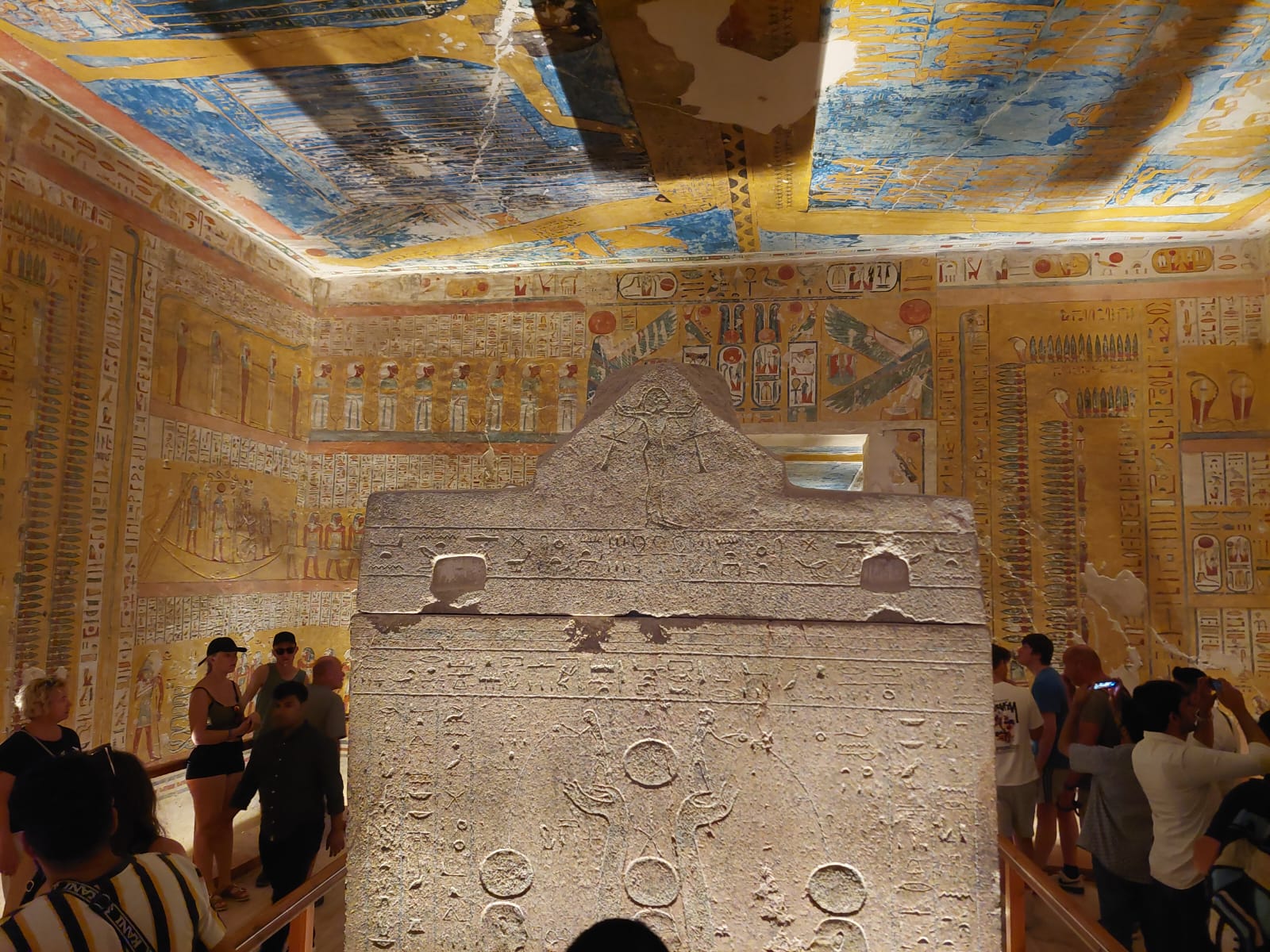
- The tomb of King Seti I was discovered on October 17, 1817 AD.
- Discover Temple of Abu Simbel in Aswan.
- to open Pyramid of Khafre In Giza.
- He stole Obelisk Elephantine Island from Aswan and the upper half of King Ramesses II and transferred to The British Museum.
- Discover the tomb of the king, who ruled the throne of Egypt after the death of King Tutankhamun after he married his wife Queen Ankhesenamun.
- He discovered a non-royal tomb that had no inscriptions and was incomplete, and it contained two mummies of two women.
- Discover Tomb of Prince Mantu Hurr Khubshef Son of King Ramses IX in 1817 AD.
- Discover a cemetery King Ramesses I.
- An alabaster coffin was discovered inside the tomb of King Seti I. The king’s mummy was not found, as the royal treasures were stolen from the tomb by tomb robbers.
- Many Ushabti statues were found inside the tomb.
- He stole the alabaster coffin of King Seti I and sold it to a wealthy man in England for 2,000 Egyptian pounds. It is currently on display in the Swan Museum in London.
- He cleaned tomb No. 7 from sand to a depth of 55 meters from 1817 AD until 1827 AD, and did not discover any treasures inside the tomb.
- He undertook many adventures to search and excavate for Pharaonic treasures in the city of Berenice in the Red Sea and The Temple of Philae in Aswan.
- He published books telling about his adventures inside Egypt and his journey to discover the royal tombs and Pharaonic antiquities.
- An exhibition was held in Baccadilly in 1821 AD to display models of the base of columns in the tomb of King Seti I, the Abu Sameel Museum, the Pyramid of Khafre, and a model of a statue God Sekhmet a lion’s head, many Pharaonic Ancient Egyptian Papyrus, and mummies were presented for sale at a public auction.
- Availability Giovanni Battista Belzoni on December 3, 1823 AD, after a struggle with dysentery in Africa.
Napoleon’s campaign in Egypt:
The French expedition to Egypt came in 1798 AD and included 4,000 combat soldiers and 139 French scientists and artists.
Commander Napoleon Bonaparte directed the French mission of professional archaeologists and artists to collect all information about Ancient Egypt History and build a complete map of all Egyptian Pharaonic antiquities.
At the end of the expedition, the French mission presented a huge volume of 5 sub-parts entitled “Description of Egypt”, in addition to designs and maps of archaeological sites and the Valley of the Kings area in Luxor. 16 royal tombs and antiquities of the West Bank were recorded, where they were recorded for the first time The Tomb of Amenhotep III No. KV22 on the western mainland.
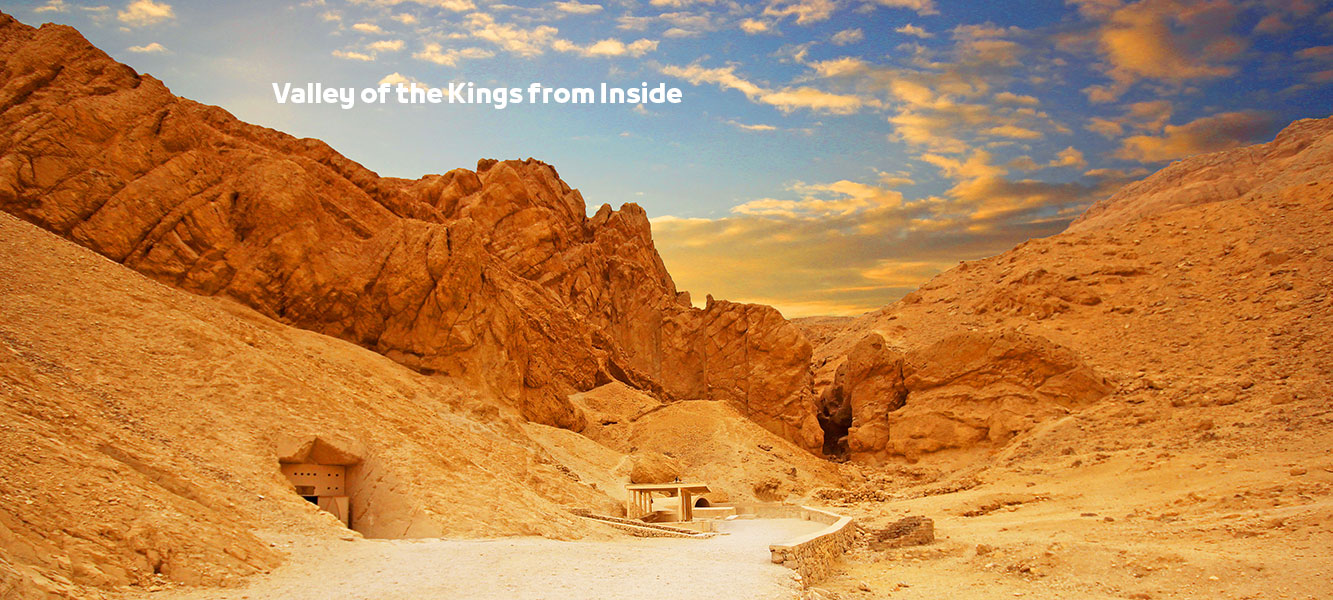
A Step by Step guide to Egyptian Mummification – Stages of mummy burial in the tombs of the kings:
The first stage:
It was a prehistoric ancient Egyptian known as “Predynastic Period , Naqada III, Dynasty 00, Dynasty 0“, where the deceased or the king was buried underground in the desert, wrapped in an animal skin or a mat, positioned cross-legged towards sunrise, but over time the body completely decomposed as a result of the drying of the desert sand and soil surrounding the body.
The second phase:
Stages passed Mummification Several stages passed until the mummification was completely completed To indicate the development of Medicine in ancient Egypt, starting with the Third Pharaonic Dynasty, in addition to the burial methods and methods of building tombs, including placing the deceased in a wooden coffin surrounded by linen wrappings.
The mummified arm of a woman was discovered with a group of jewelry around it in the tomb of King Djer of First Dynasty of Egypt in the Umm El Qa’ab Tombs area – Abydos, Sohag.
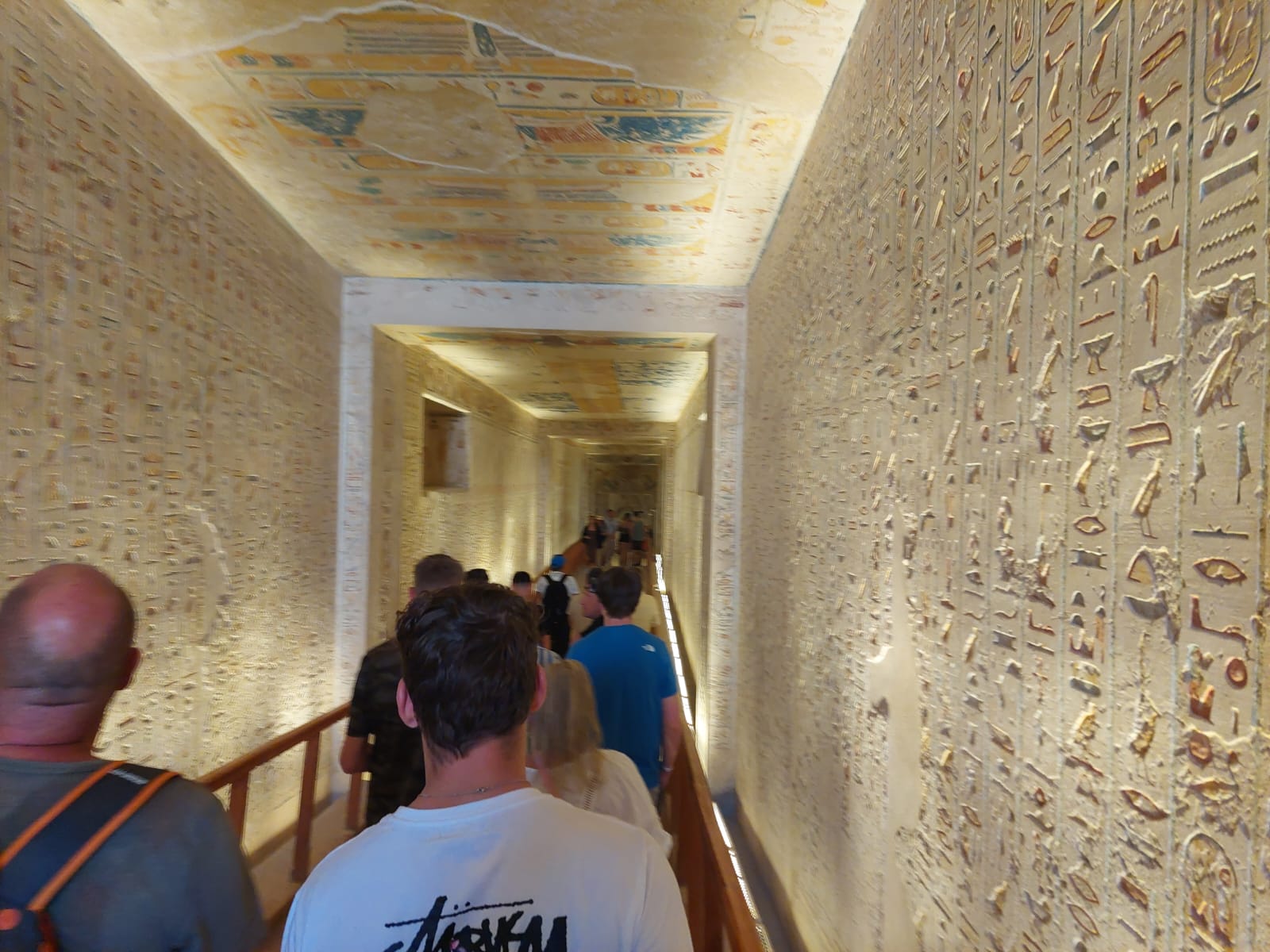
Stages of development of the tombs of the Pharaohs:
- The tombs of the kings of the Old Kingdom were of a different design, as the king’s burial chamber was under a for a Pyramid Inside, this was an easy way for tomb robbers to steal treasures and gold from the royal tomb.
- in age The Middle Kingdom in ancient Egypt “The beginning of the rule of King Mentuhotep I of the Eleventh Dynasty of Egypt“, The ancient Egyptian engineer designed the pyramid in a smaller size and added complex internal corridors and vestibules, but this method did not succeed in preserving the mummy and the king’s treasures from theft, plunder and vandalism.
- Starting from the 18th Dynasty, a search was made for an abandoned place far from people and difficult to reach, until the Valley of the Kings behind the plateaus was chosen to build the royal cemetery in the mountain rock in the western Thebes region.
- Texts and drawings from funerary books were used on the walls of the tombs, such as the Book of Gates, “Chat-im-Saba”, and the Book of Emi.
valley Burial of kings:
It contains Valley of the Kings contains the tombs of the sons of King Ramses II and the queens and princesses of the Pharaohs from the ruling family, in addition to a small group of high-level officials in the government of ancient Egypt’s civilization.
the design architect is the basis for the design of the royal tomb in order to prevent tomb thieves from stealing it. The tomb’s design consists of a long corridor with columns and a long corridor downwards at the end of which is the mummy’s burial room, which includes the king’s coffin and an adjacent room to store the royal furniture and food for use by the royal family. his afterlife, in the afterlife after death.
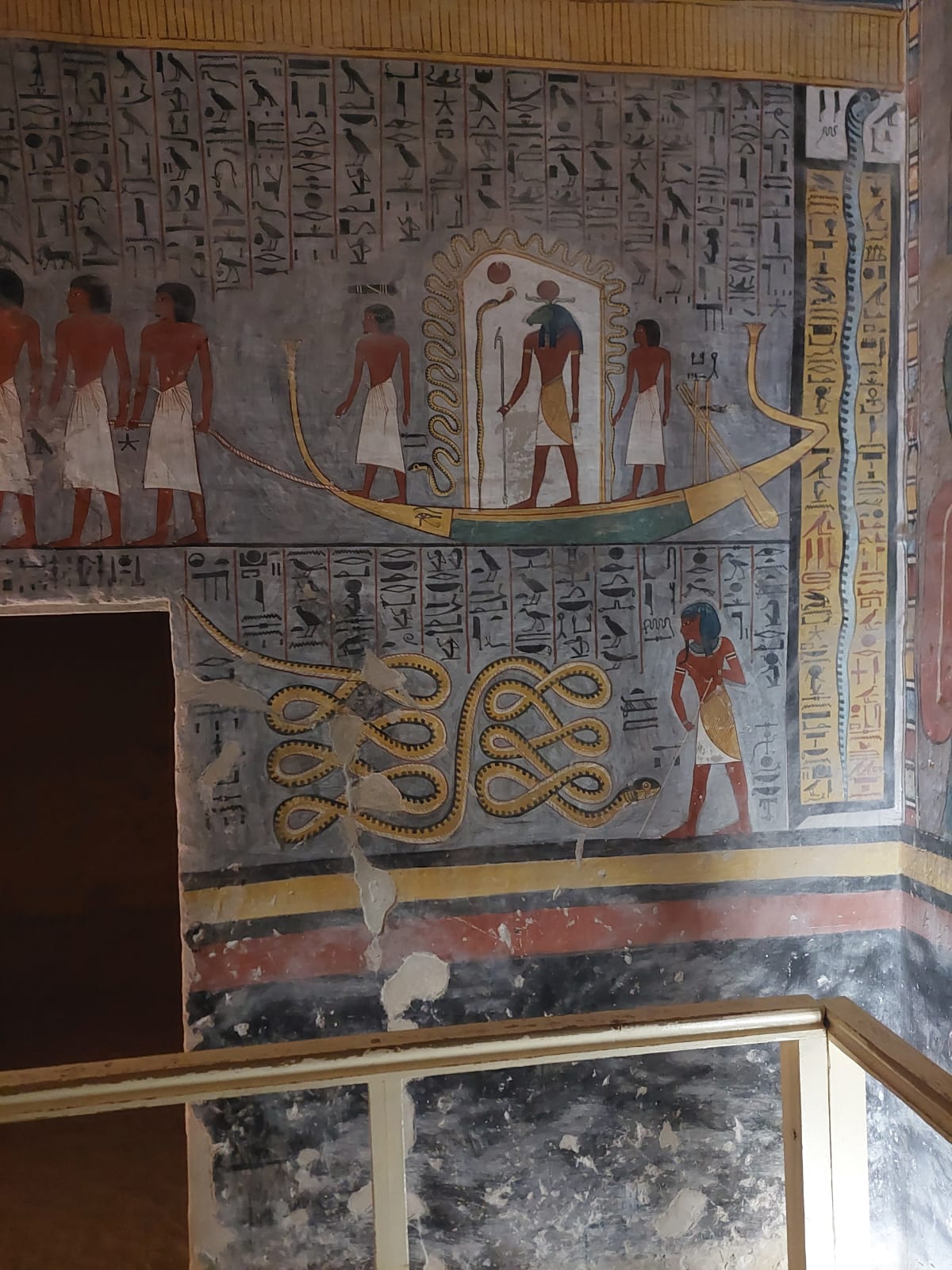
Coordinates Valley of the Kings:
Located The Pharaonic royal tombs are in an isolated valley on the top of Mount Qurna on the west bank of the Nile River in a pyramid shape, surrounded by steep slopes in the ancient city of Thebes and currently Luxor..
valley Ancient pharaohs:
- All the tombs were stolen from tomb thieves in the era of the New Kingdom, and then those searching for Pharaonic antiquities in modern history stole the treasures and mummy and sold them outside Egypt..
- In ancient times, cemeteries were exposed to the danger of floods and torrents.
- Each visitor leaves behind a level of carbon dioxide, in addition to the rate of excess sweat in the summer months and high temperatures, which negatively affects the quality of the drawings, engravings, and color tone on the walls..
- Screens and glass panels were installed on the walls to protect them from sweat, humidity and carbon dioxide emitted by every visitor to the Pharaonic tomb..
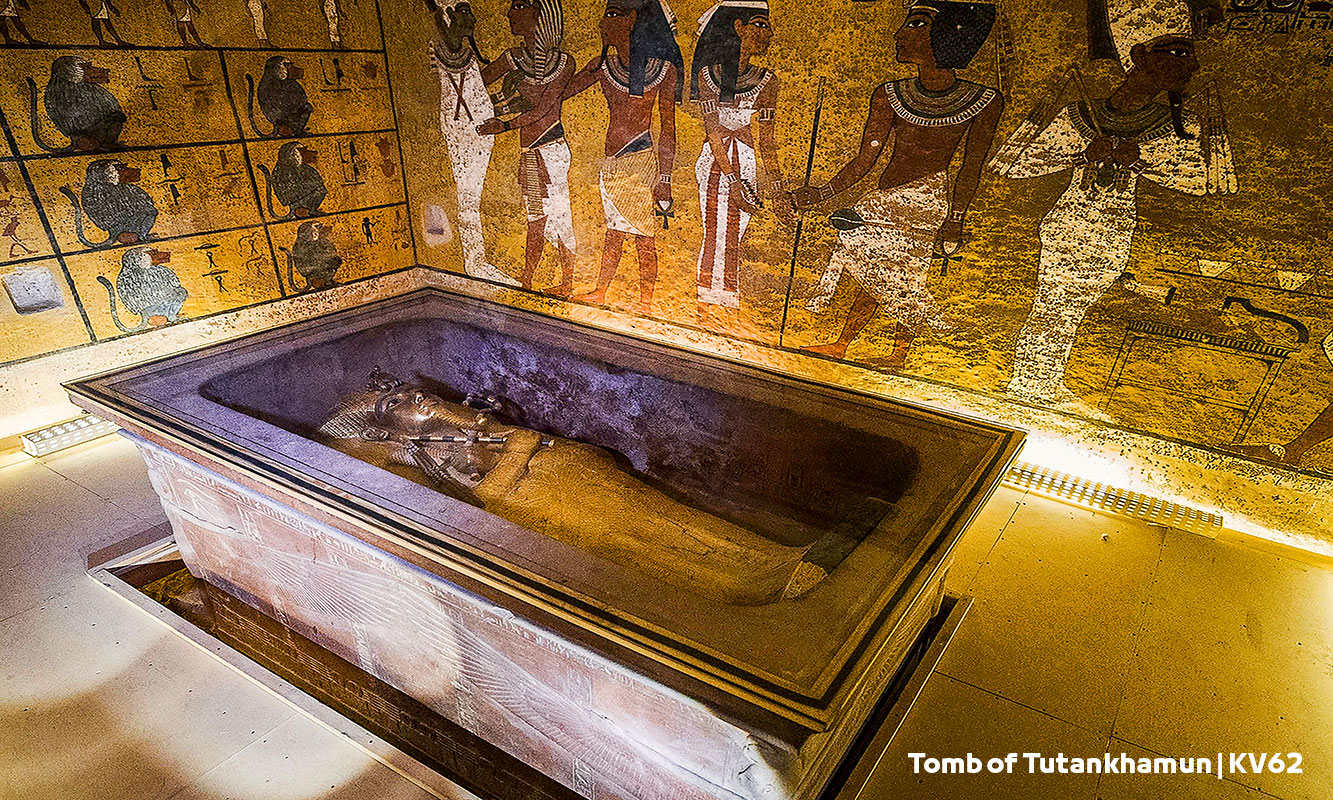
Tomb of Tutankhamun | KV62
considered as The young king Tutankhamun is one of the most famous royal pharaonic tombs in the Valley of the Kings. The mummy is now kept only inside the burial chamber inside a royal coffin, and the rest of King Tut’s treasures are completely displayed in the Grand Egyptian Museum in Giza.
It was completed the tomb was discovered through years of continuous attempts by archaeologist Howard Carter after he carved a hole in the inner wall of the tomb and then discovered that it still contained all of the king’s furniture and military equipment..
still The walls of the tomb retain the quality of the Pharaonic drawings and engravings on the walls until now, and they are restored from time to time.
Believes It was not the original cemetery to bury King Tut’s mummy, and it was intended for another Pharaonic king, but due to his sudden death when he was young, he was quickly buried in this cemetery..
when The 20th Dynasty ended. Ancient Egypt was completely divided, and every ruler of a state or region began looking for sources of gold and another alternative to building his own tomb..
It was completed Building the tombs of the nobles next to the royal tombs in Jebel Qurna, with the spread of the theft of treasures and gold from the tombs of kings and queens..

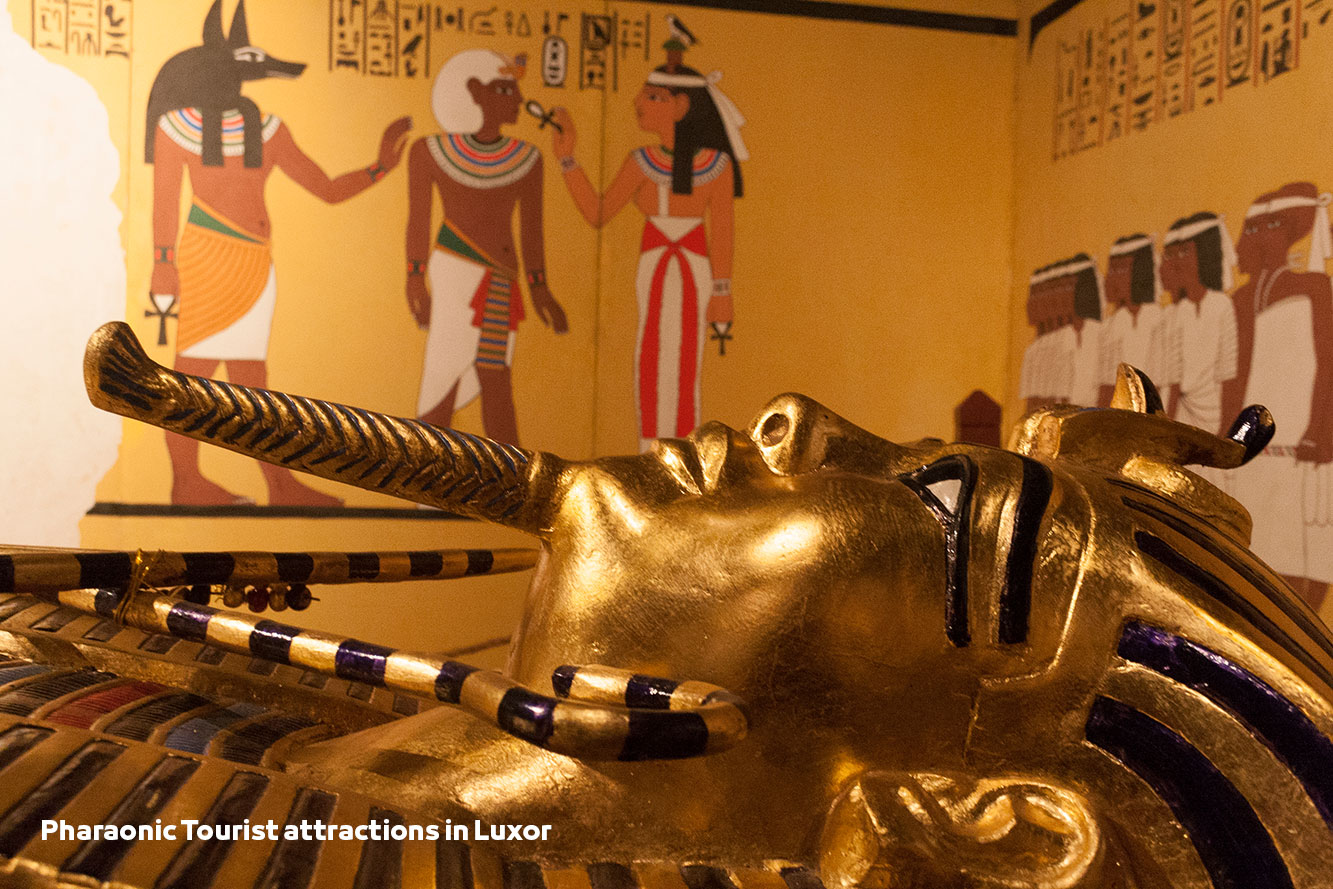
Valley of the Kings address:
Western, Qurna, Luxor.
Valley of the Kings opening hours:
Daily from 6 am to 5 pm.
Valley of the Kings Entry ticket prices:
Note: The prices of entry tickets to the Valley of the Kings tombs and all the royal tombs will be increased starting from June at an increase rate of about 30% or more.
Adult Visitor =600 Egyptian Pound
Entrance tickets to Tutankhamun’s tomb
Visitor = 500 Egyptian pounds
Entrance tickets to the tomb of Ramesses VI
Visitor = 200 Egyptian pounds
Entrance tickets to the tomb of Seti I
Visitor =1400 Egyptian Pound
Entrance ticket prices to Ay Cemetery
Visitor = 100 Egyptian pounds
50% discount for all students and children from 6 to 12 years old.
Free entry policyIn the Valley of the Kings:
- Free entry for children under 6 years old for all nationalities.
- Free entry for Egyptians and Arabs with special needs.
- Free entry for Egyptians and Arabs over 60 years old Just.
- Mobile phone photography is freeIn the Valley of the Kings.
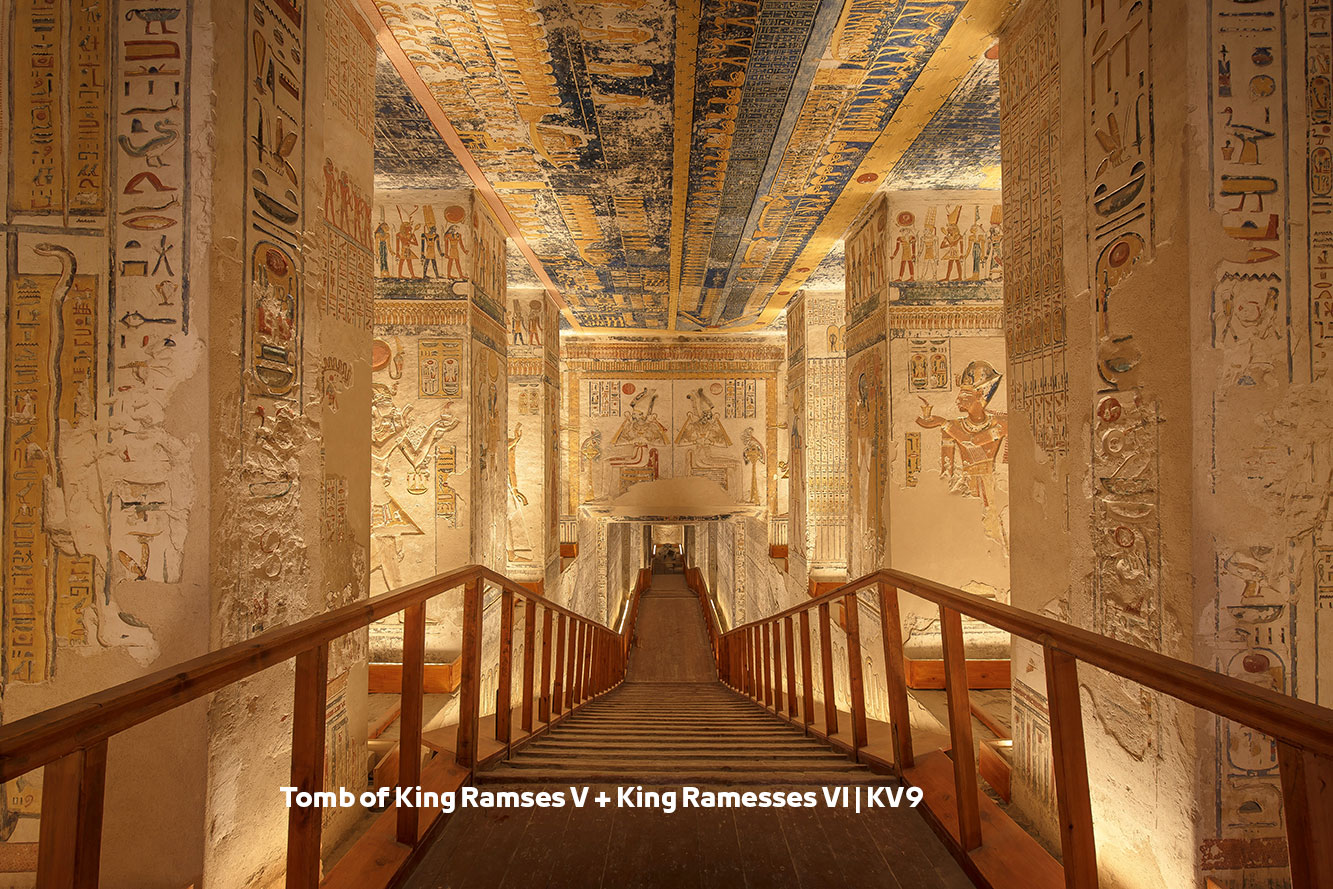
FAQ – questions and answers:
What is the purpose of the tombs of the Valley of the Kings?
The aim of building royal tombs was for the Pharaonic dynasties and nobles of the Eighth Dynasty ten, The Nineteenth Dynasty and the Twentieth Pharaonic Dynasty, the era of the New Kingdom in ancient Egypt in the history of ancient Pharaonic civilization.
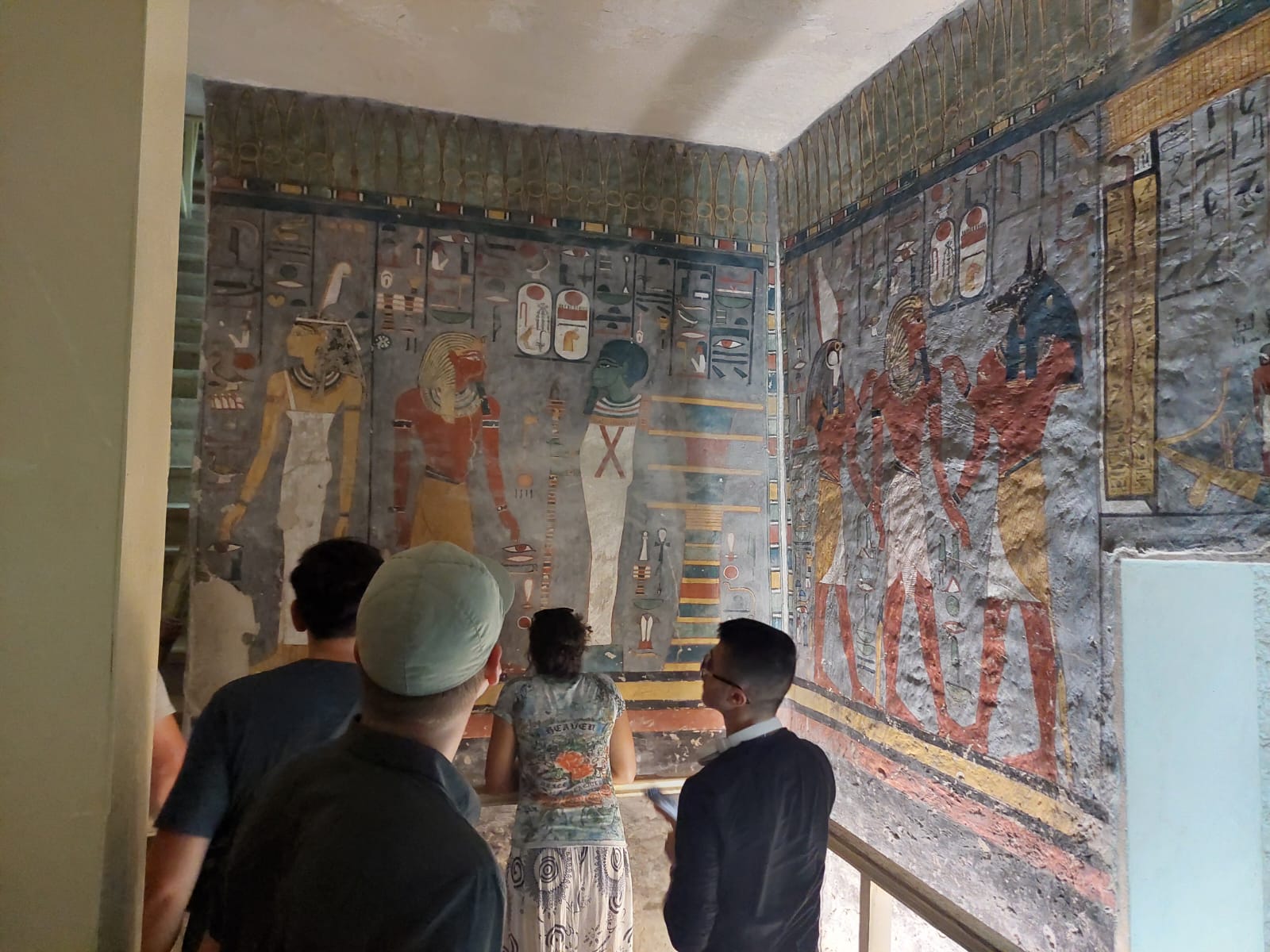
When did the construction of tombs start?
The Valley of the Kings area was used for more than 500 years BC, as the construction of Pharaonic tombs began from the eleventh to the sixteenth century BC.
How Were the tombs in the Valley of the Kings numbered?
KV = Kings’ Valley
WV = West Valley
A literal was used KV is preceded by the number of each tomb, where numbers in order of priority begin to be discovered.
Complete Literal use WV of the Royal Tombs in the Arabian Valley of the Valley of the Kings.
Who are the thieves of the Valley of the Kings tombs?
Have been found Papyrus from the 20th Dynasty, Pharaonic royalty and knowledge Meyer papyri a group of people were tried for stealing the tomb of King Ramesses VI, and the trial was recorded during the rule of King Ramesses IX..
The thieves would enter the cemetery, steal the mummy from the coffin, and steal all the gold and everything valuable..
It is considered the tomb of King Tutankhamun and a cemetery Yuya And Toya and Cemetery No. KV63, where all the relics and possessions buried with the king were discovered, and their coffin was found in the burial chamber..
Are the tombs of the Valley of the Kings available to visit?
- There are only 18 cemeteries that a visitor, whether Egyptian or foreign tourist, can visit.
- There is a fee so you can visit the tomb of King Tutankhamun and the tomb of King Seti I.
- Visitors are allowed to visit the 18 cemeteries according to the times and are not allowed to visit them at the same time.
- Tour guides accompanying the tourist delegation are prohibited from entering any cemetery.
- It is prohibited to take pictures inside graves, especially those that contain a flash.
- To take many photos inside the cemetery, you must obtain security permits.

What Did they contain royal tombs?
- Tools that the king will need in his second life after death.
- Magic spells Ushabti statues as in Magic in ancient Egypt.
- Statues of gods and religious beliefs and Scarab.
- Funeral furniture collectibles and Pharaonic royal food of the king in his first life in this world.
from Is it the first tomb in the Valley of the Kings?
considered as The King’s Tomb The Tomb of King Tuthmosis I was the first tomb to be built in the Valley of the Kings area in Luxor.
when Was the Valley of the Kings started to be used as royal tombs?
It was completed The Valley of the Kings was used for the first time in 1539 BC to bury the Pharaoh kings from the modern countries until 1075 BC..
Do Are there other tombs near the Valley of the Kings?
It was completedBuilding a group of tombs for nobles and people close to the Pharaoh kings Theban Tombs, Tombs of Gournet Merii, Tombs of Draa Abu Al-Naja, Tombs of Al-Assassif, Tombs of Sheikh Abdel Gorna In addition The cemetery of El Muaalla, Tombs of El Khokha and cemeteries Valley of the Queens Concerning the wives and children of for kings Pharaohs and a group of ministers in the ruling family.
He rose King Ramses I built the Valley of the Queens tombs near the Valley of the Kings area in 1301 BC.
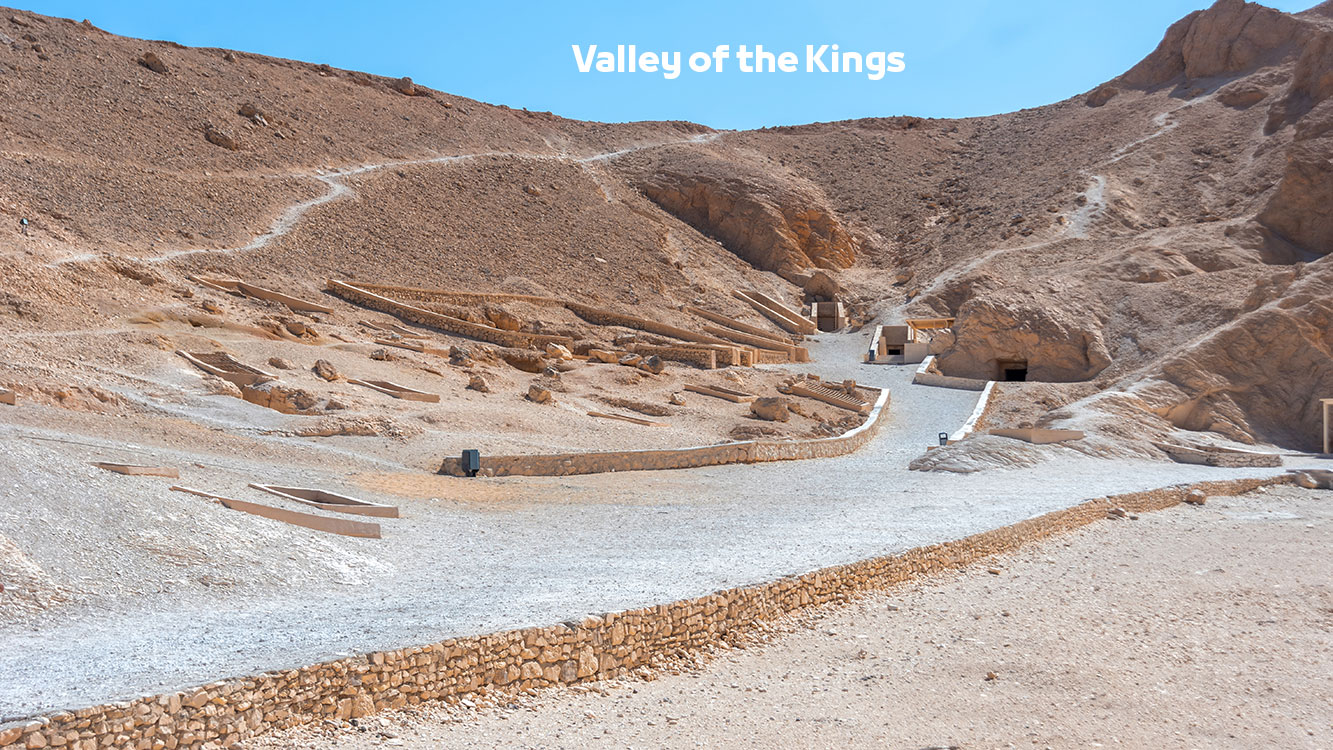
What Is the royal funerary city in the Valley of the Kings?
He was The Valley of the Kings is called the Royal Funeral City in the Pharaonic civilization, which means the name of the city Hieroglyphic language Ta Sikhet Maat means the Great Valley in the ancient Egyptian language.
According to Royal traditions of the 18th Dynasty: The Pharaonic king was buried next to his father’s tomb, and nobles were buried in a carved room next to the cemetery, as one of the funerary beliefs in ancient Egypt..
in At the end of the 18th Dynasty, King Tutankhamun reburied the kings in the Valley of the Kings again after he rose King Akhenaton, He moved his grave to the city of Tell el-Amarna.
Take care The kings of the 19th and 20th Dynasties built royal tombs for each king in the Valley of the Kings and tombs for the queens and their sons in the Valley of the Queens, especially during the reign of King Ramses II Sunday, The most important and famous ancient Pharaoh kings.
He was The kings depend on the ancient Egyptian sculptors and workers in the village of Deir el-Medina, where the small village is located between the hills of the Valley of the Kings and the Valley of the Queens..
What was the first tomb built in the Valley of the Kings?
It is considered the tomb of King Tuthmosis I or a royal tomb that was built and dug into the rock of the mountain, but the entire tomb was stolen and the king’s mummy was transferred to the tomb of Queen Hatshepsut and then transported again by the priests of the Temple of Amun to the cache of mummies in Deir el-Bahri in Luxor.
The Deir el-Bahari cache was discovered in 1881 AD inside the En-Hapi cemetery No. 320. 40 mummies were found in good condition and are now displayed in the Egyptian Museum in Tahrir.
What are the difficulties faced in building tombs in the valley?
It contains the valley contains a layer of large rocks that are considered difficult to dig in, in addition to a layer of surface shale in the valley areas, which causes greater efforts to be made in building the Pharaonic tomb or properly preserving the mummy of the Pharaohs..
where When water falls, the rocks are separated by large distances between the wall and the floors of the Pharaonic tomb, which causes rainwater and floods to easily enter the tomb and thus causes damage to the walls, drawings and engravings, and damage to the texts of coffins and mummy..
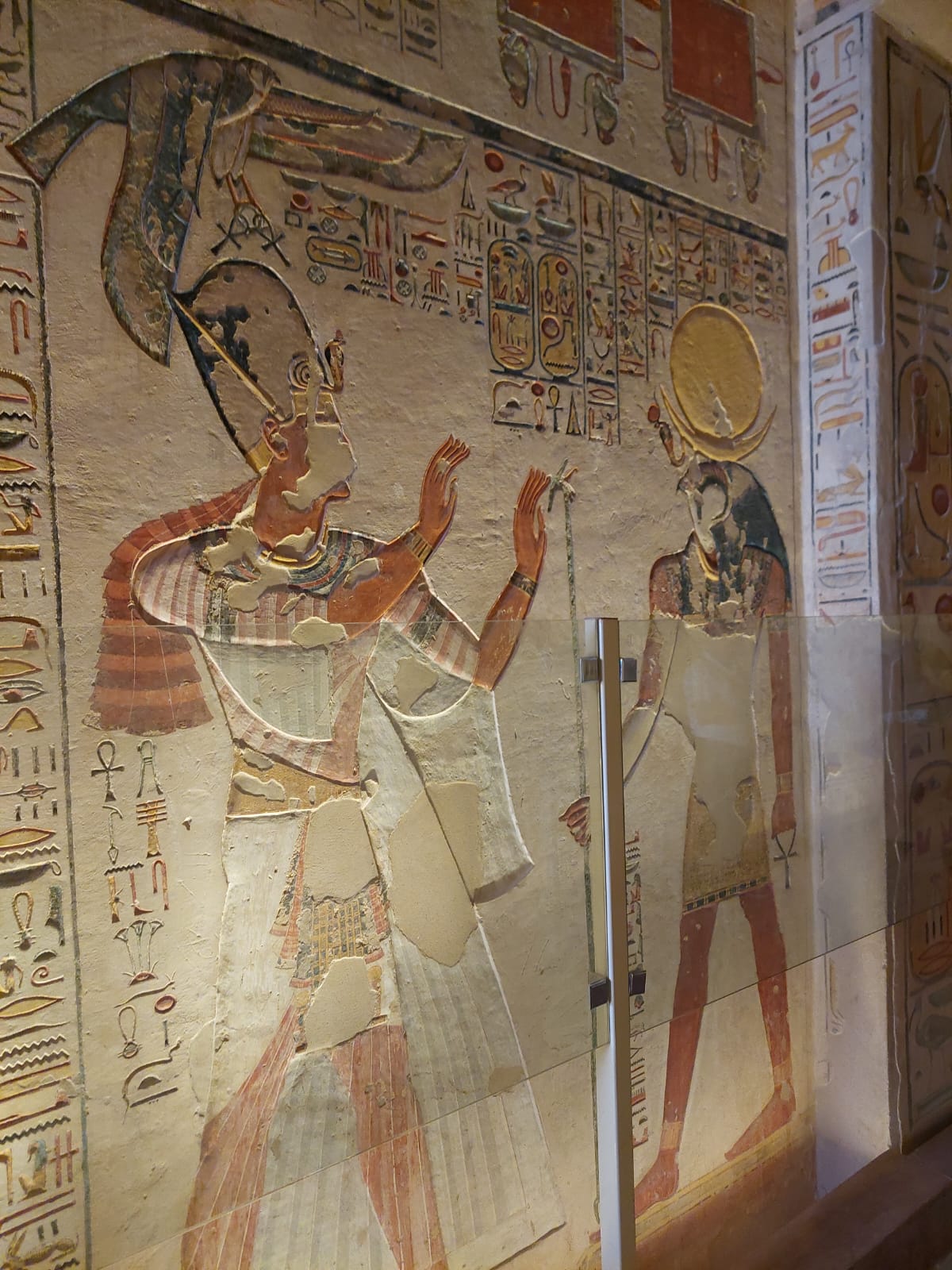
How Were tombs built in the Valley of the Kings?
- A group of Pharaonic royal tombs were excavated between the cracks in large limestone layers.
- Another group of Pharaonic tombs was built behind the rubble of rockslides or the slope after the end of the Nile River flood.
What is the Valley of the Kings famous for?
- Contain itOn the tombs of the kings of the Pharaohs and the rulers of the Pharaonic dynasties 18, 19, and 20 in the period 1550 and 1069 BC..
- DiscoveryThe entire treasures of King Tutankhamun’s tomb.
Do Valley of the Kings worth a visit?
YesIt is worth a visit, as it contains drawings and engravings that still retain their colors.
what Are 5 facts about the Valley of the Kings?
- A number of the royal Pharaonic family were buried, in addition to a number of regional governors and priests with an authority in the government of ancient Egypt..
- Contains 65 royal cemetery and 20 unfinished tombs, drawings and inscriptions.
- The current location was chosen on the western mainland from the course of the Nile River because the sun god of the ancient Egyptians set from the western direction in order to be born again..
- All the tombs were stolen except for the tomb of the young king Tutankhamun, which was discovered by Howard Carter and all the belongings in The Grand Egyptian Museum in Giza.
- There are still secrets and tombs that have not yet been discovered in the Valley of the Kings.
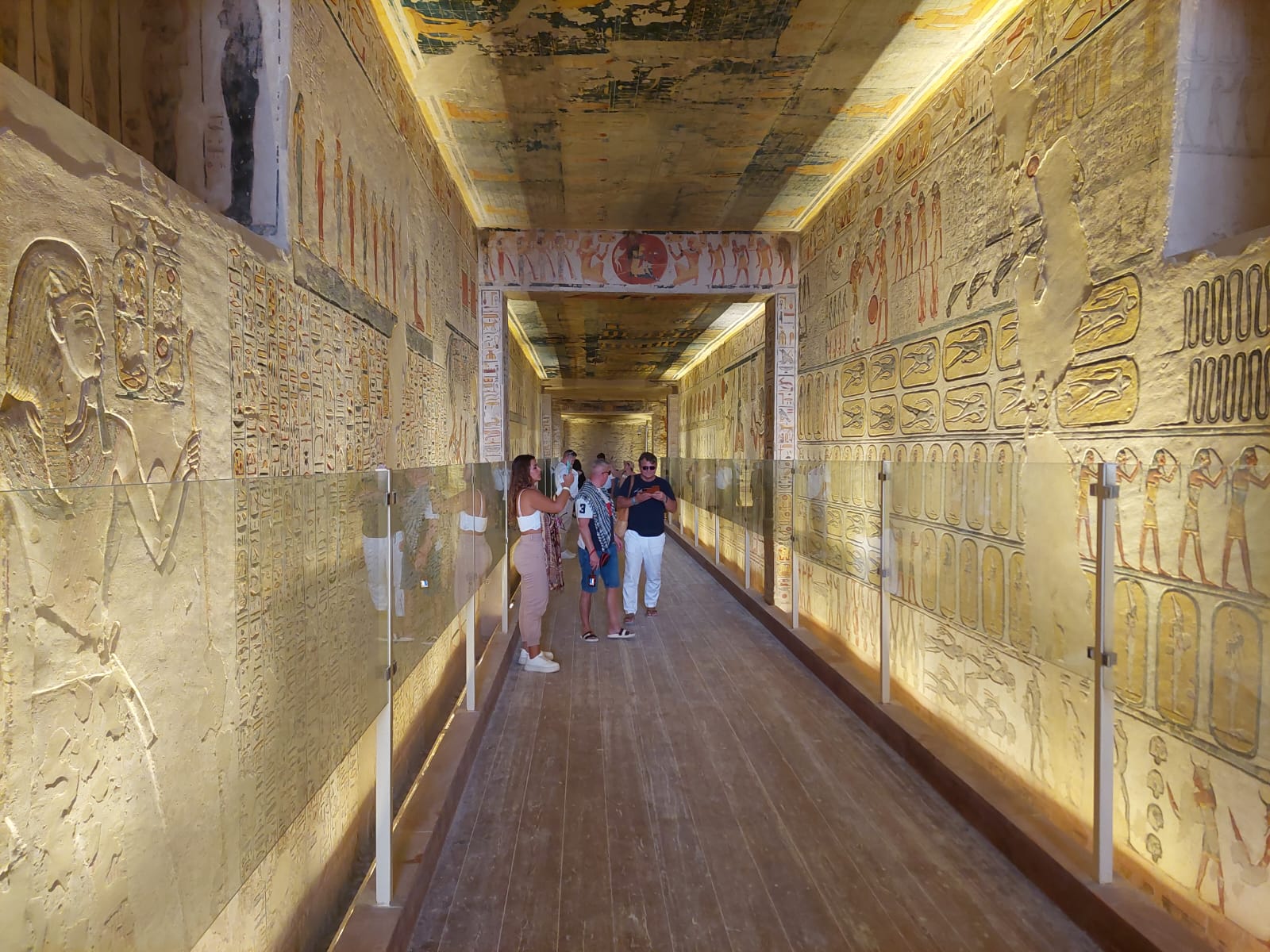
What happened in the Valley of the Kings?
It was completed Building tombs in the ancient city of Thebes and stealing all of them, except for King Tut’s tomb.
Why Is Egypt called the Valley of the Kings?
a reason The Valley of the Kings is named after the burial of kings and members of the Pharaonic royal family.
How much does it cost to go to the Valley of the Kings in Egypt?
Could you Go there by taxi or rent a car from your hotel in the tourist city of Luxor.
If you are in Cairo and Alexandria, you can go by booking a flight, renting a tour, booking a Cairo train, booking a bus, a private trip, or a private car..
If you are in Hurghada, Soma bay, Makadi bay, El Gouna, Sahl Hasheesh and want to take a day trip to Luxor from Hurghada, It is preferable to book a tour through our website or a tour operator in Hurghada.
What is the best time of year to visit the Valley of the Kings?
It is considered October to April are among the best times to visit the tombs of the Valley of the Kings in southern Egypt, as the weather is moderate and temperatures are suitable for all ages, especially the elderly and children..
noIt is preferable to visit the Valley of the Kings in the summer months in Egypt, when temperatures and humidity are very, very high.
What Is the biggest threat to the Valley of the Kings?
- Rainwater and torrential rains in winter, and the occurrence of flooding through torrents descending into the graves from the top of the mountain..
- Humidity and salts, which expose drawings and engravings to danger, damage and deterioration.
- Visitors use cameras and mobile phones that support flash.
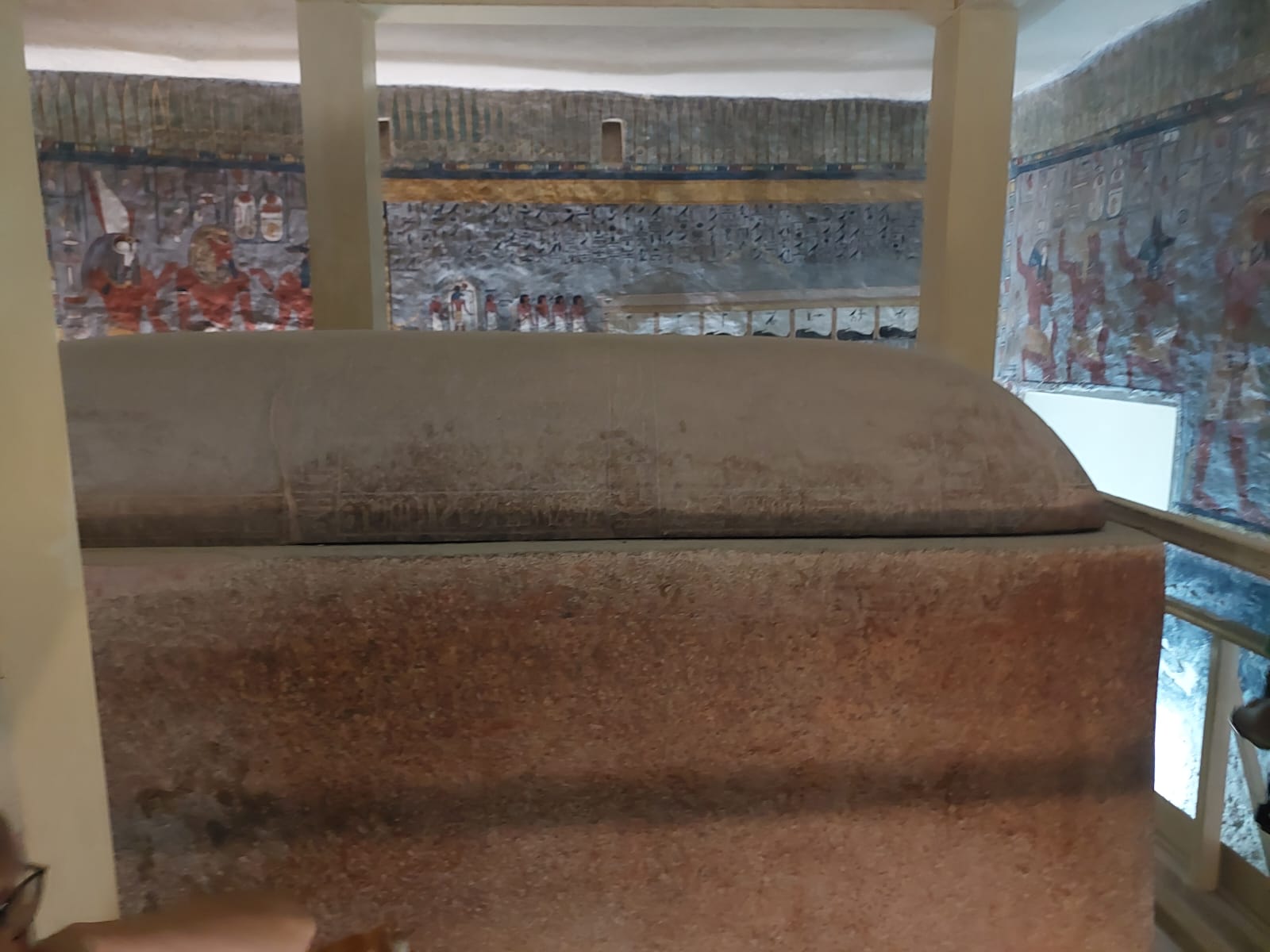
Do Can you take pictures in the Valley of the Kings?
- may be Taking pictures in the Valley of the Kings only using a mobile phone without flash technology.
DoCan you walk in the Valley of the Kings?
- You can start transportation cars A small way to climb to the top of the mountain and then walk between the tombs available to visitors and tourists.
How much does it cost to enter Tutankhamun?
price Entrance ticket to King Tutankhamun’s tomb for adults for 500 Egyptian pounds and a 50% discount for children and students.
What The difference between the Valley of the Kings and the Valley of the Queens?
the difference The Valley of the Kings was buried the mummy of male members of the ruling Pharaonic family, while in the Valley of the Queens the mummy of female members of the ruling Pharaonic family of princesses and queens was buried..
How Was the Valley of the Kings hidden?
nature The valley is an isolated area between the mountains in the Qurna region. The cemetery was dug inside the mountains in a complex pyramid shape that is difficult to reach. Despite this, all the Pharaonic tombs were stolen except for the tomb of King Tutankhamun.
Hurghada Excursions Lovers, Best Travel Agency in Hurghada to provide daily tours to visit the Tourist attractions of Luxor by Hurghada to Luxor Tours and Hurghada to Pyramids Trips. Book online when you come to Hurghada, El Gouna, Sahl Hashish, Makadi Bay, Soma Bay, Egypt.
Video:


